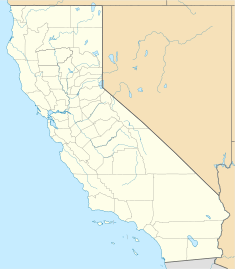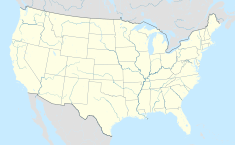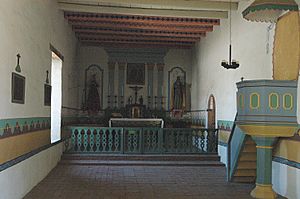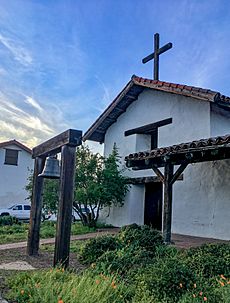Mission San Francisco Solano facts for kids
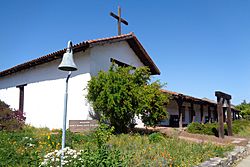 |
|
| Location | 114 E Spain St Sonoma, California |
|---|---|
| Coordinates | 38°17′38″N 122°27′21″W / 38.29389°N 122.45583°W |
| Founding date | July 4, 1823 |
| Founding priest(s) | Father José Altimíra |
| Founding Order | 21 |
| Military district | Fourth |
| Native tribe(s) Spanish name(s) |
Coast Miwok, Patwin, Pomo, Suisunes, Wappo |
| Native place name(s) | Huchi |
| Baptisms | 1,563 total |
| Marriages | 359 total |
| Burials | 896 total |
| Neophyte population | 996 in 1832 |
| Governing body | California Department of Parks and Recreation |
| Current use | Museum |
| Reference no. |
|
| Website | |
| http://www.parks.ca.gov/?page_id=479 | |
Mission San Francisco Solano was the 21st and last mission built in Alta California. It was also the northernmost one. This mission was named after Saint Francis Solanus. It was special because it was the only mission built after Mexico became independent from Spain.
Its beginning was a bit confusing due to this change in government. The California Governor wanted Mexico to have a strong presence north of the San Francisco Bay. This was to stop the Russians, who had a settlement at Fort Ross, from moving further inland.
At the same time, a young Franciscan friar from Mission San Francisco de Asis wanted to find a new location. He hoped for a better climate and more Native Americans to teach about Christianity.
Even though it only lasted eleven years, the Mission was successful. It was smaller than older California missions. It had fewer converts and produced less.
Today, the mission building is part of the Sonoma State Historic Park. You can find it in the city of Sonoma, California.
Contents
The Mission's Story
The mission was founded in 1823. Over its short life, different priests and friars managed it.
Father Altimira's Vision
Father José Altimira came from Barcelona, Spain, when he was 33. He served at Mission San Francisco de Asís. That mission wasn't doing well because of its cold climate. A special health center, called an asistencia, had been set up in San Rafael. It helped sick Native Americans, called neophytes, get better.
California Governor Luis Argüello was worried about the Russians. They were at Bodega Bay and Fort Ross. He wanted to stop them from expanding. Father Altimira and the Governor came up with a plan. They wanted to move Mission San Francisco de Asís and the San Rafael health center to a new spot north of the Bay. The government agreed, but the church leaders didn't reply right away.
In 1823, Father Altimira started looking for a good mission site. He had soldiers with him. On July 4, 1823, they placed a large redwood cross in the Sonoma Valley. This was where they planned to build the new mission. They held a special church service there. Then, they went back south to gather people and supplies.
The area they chose was already home to many Native American groups. These included the Coast Miwok, Southern Pomo, Wappo, Suisunes, and Ptwin peoples. Soldiers from the Presidio of San Francisco would protect the mission and the neophytes.
Father Altimira returned to Sonoma in late August with soldiers and neophytes. He decided on a different, better spot across the valley. But soon after starting, he received a letter. The head of the church, Father-President Sarria, told him to stop building. Father Altimira obeyed.
After some talks between leaders, an agreement was reached on September 30. A new mission could be built, and Father Altimira would lead it. However, Mission San Francisco de Asís would stay open. Also, the San Rafael health center was already made into a full mission.
So, in October 1824, Father Altimira began building his new mission. Since Mission San Francisco de Asís was still open, this new mission needed a different patron saint. Altimira chose San Francisco Solano. He was a Franciscan missionary from the 1600s who worked in South America.
His group of soldiers and neophytes started building everything a California mission needed. His report for 1823 showed no baptisms, one marriage, and one funeral. The mission had 482 Native Americans, all from other missions. They also had 1341 animals. It was too late in the year to plant or harvest crops.
On April 4, 1825, Father Altimira dedicated his church. It was a simple, temporary building made of whitewashed boards. But it was well-furnished and decorated. Many items were gifts from the Russians at Fort Ross. It also had a painting of San Francisco Solano. The mission was even promised a special relic of the saint.
The Mission grew until 1826. An argument happened over sharing the harvest. Native Americans who didn't live at the Mission were unhappy with their share. They burned some wooden buildings in protest. Father Altimira and a few loyal neophytes fled to Mission San Rafael Arcángel.
Father Fortuni Takes Over
Father Buenaventura Fortuni replaced Altimira. He was an older Spanish Franciscan from Mission San José. Father Fortuni quickly brought back order and good spirits. The work of building the mission started again. He arranged the main buildings to form a large, square area.
By 1830, Father Fortuni had worked alone at the mission for three and a half years. He was 58 and wanted to move to a mission where he could share the work. In 1826, the Mexican government had said that Spanish friars who wouldn't promise loyalty to Mexico had to leave. Father Fortuni was allowed to stay, but new churchmen had to take the pledge.
Father Gutierrez's Leadership
Father José Gutiérrez, a Franciscan friar from South America, took over from Father Fortuni. Father Gutierrez continued building and grew the farming efforts. By 1832, the mission had 27 rooms in the convento, or priest's living area. There was a large adobe church at one end. A wooden storehouse, which was the first mission chapel, was at the other end.
Workshops completed the square area. Here, Native Americans learned to be craftsmen. They made things the mission needed to support itself. Along the back of the courtyard were living and work rooms for young Native American girls.
Beyond the main square, there were orchards, gardens, vineyards, and fields of grain. There was also a gristmill for grinding grain. Houses for soldiers and Native American families, a jail, a cemetery, and a hospital were also part of the mission.
The year 1832 was the most successful for this mission. Father Gutierrez's report for that year showed:
- 127 baptisms (new converts)
- 34 marriages
- 70 deaths
- A total of 996 neophytes (from 35 local villages)
- Livestock included 6,000 sheep and goats, 900 horses, 13 mules, 50 pigs, and 3,500 cattle.
Crops were measured in fanegas, which are old Spanish units of volume. In 1832, the mission produced:
- 800 fanegas of wheat
- 1025 fanegas of barley
- 52 fanegas of peas
- 300 fanegas of corn
- 32 fanegas of beans
- 2 fanegas of garbanzos (chickpeas)
The Mission Closes Down
In 1833, the Mexican government decided to close all the missions in Alta California. This was done through a law called the Mexican secularization act of 1833. Governor José Figueroa then created rules for how to give out the mission property. This included land, cattle, and tools, to the neophytes.
The rules stated that each family head and anyone over 20 years old would get a piece of mission land. This land would be between 100 and 400 varas square (about 7 to 28 acres). They would also receive half of the livestock and half of the tools and seeds.
Mission San Francisco Solano officially closed on November 3, 1834. It became a regular church parish. Spanish missionaries were replaced by parish priests. Father Lorenzo Quijas, who had worked in Sonoma and San Rafael, was the first.
Lieutenant Mariano Vallejo was put in charge of closing the Mission. Father Quijas moved back to San Rafael in July 1835. He had many disagreements with Guadalupe Antonio Ortega, who was Vallejo's assistant for the closing process. Father Quijas complained about Ortega's actions. However, the Governor was very sick and died soon after, so nothing was done. Ortega was finally removed in 1837 due to new problems.
After Father Quijas left, the number of neophytes quickly dropped. Most went back to their home villages. They took their belongings with them. Others moved to ranchos, like Vallejo's Rancho Petaluma Adobe, to work. Some stayed in Sonoma as servants. Some former Mission Native Americans reportedly received their land and cattle. But these small land plots were not officially recorded.
In 1839, the government sent William Edward Petty Hartnell to check on the missions. But Vallejo avoided him, saying he was too busy with military matters. So, the closing of the Sonoma mission was never properly reviewed.
The Mission Falls Apart
The mission buildings quickly started to fall apart. The town of Sonoma was growing, and people needed building materials. Roof tiles, wooden beams, and adobe bricks were taken from the mission buildings. After settlers took what they needed, nature began to reclaim the rest.
In 1841, Mariano Vallejo ordered a small adobe chapel to be built. It was placed where the first wooden mission chapel had stood. This new chapel became the town's church. It replaced the large mission church, which was falling apart. This chapel was at the west end of the Convento, so people often thought it was the original mission church.
In 1863, President Abraham Lincoln gave ownership of all California mission churches back to the Roman Catholic Church. In 1881, the Sonoma church property was sold to a local businessman. A new parish church was built elsewhere in town. For a time, the old adobe chapel was used as a warehouse. The Convento might have been used as a winery.
Bringing the Mission Back to Life
In 1903, two remaining mission buildings were bought by the California Historic Landmarks League. They became part of the California Park System in 1906. The Sonoma Valley Woman's Club also helped. In 1903, they raised $184 to help save the Sonoma Mission. In 1910, they leased the property and raised $800 for repairs. The Native Sons of the Golden West of Sonoma also helped them.
In 1911, the club asked the State Legislature for help. This led to $5,000 being given to restore the Mission. By 1913, both buildings had been rebuilt. After the 1940s, the former church and Convento were updated. They were made to look more like the original buildings. Now, they hold exhibits about mission history.
In 1999, the Sonoma Mission Indian Memorial was dedicated. It honors over 800 Native Americans, including more than 200 children. They died while living and working at the Mission between 1824 and 1839. Their Christian names are carved on this granite memorial.
European diseases like measles and smallpox caused many deaths. Native Americans had no natural protection against these illnesses. Also, crowded and unhealthy living conditions at all California missions contributed to the high death rate. However, the missions did try to provide healthcare with the resources they had. The first hospital in California was founded in 1817. It cared for Native Americans from Mission San Francisco de Asís. This hospital later became the independent Mission San Rafael Arcangel in San Rafael.
A California Landmark
On June 1, 1932, Mission San Francisco Solano was named California Historical Landmark #3.
Fun Facts About Mission San Francisco Solano
- Mission San Francisco Solano is the last and most northern of the twenty-one missions. These missions were built in Alta California. It was founded in Sonoma, California.
- It was the only California mission started after Mexico became independent from Spain in 1821.
- It was only used as a mission for eleven years.
- The mission had over 10,000 acres of land. This land included orchards, vineyards, and grain fields. It also had land for livestock to graze.
- The town of Sonoma was where the Bear Flag Revolt happened. This event helped separate California from Mexico.
- The mission church faces the plaza. This plaza became the center of the Bear Flag Revolt in 1846.
- Tremors from the 1906 San Francisco earthquake badly damaged the mission's original adobe chapel. The repairs were finished in 1913.
- In 1927, the California State Parks Commission became responsible for taking care of the mission. They also took care of the land around it.
- Mission San Francisco Solano is one of only two Spanish missions in California that are run as a State Park.
See also
 In Spanish: Misión San Francisco Solano para niños
In Spanish: Misión San Francisco Solano para niños
- Spanish missions in California
- El Presidio de Sonoma
- USNS Mission Solano (AO-135) – a ship built during World War II
- Sonoma Plaza – the historic area in front of the mission
- Mission Guadalupe - the last Dominican mission, founded in June 1834
- San Francisco Solano de Sonoma Mission Vineyard
- California Historical Landmarks in Sonoma County


